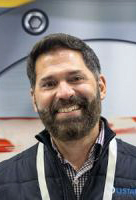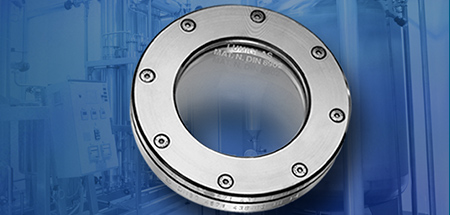
Posts by: John Giordano
John Giordano is the Director of Sales at LJ Star Inc., a market-leading manufacturer of process observation equipment. He has more than 10 years of experience working with original equipment manufacturers and food and beverage processors on specifying sanitary observation equipment to enable process monitoring and ensure the production of high-quality products. John has business administration degrees with a focus on operations management from the University of Cincinnati and Cleveland State University.Sight glasses (also called sight windows or viewports) are critical for visual inspection inside vessels, pipes, and tanks—but they also represent a potential safety vulnerability if mis-specified, improperly installed, or poorly maintained. There are a variety of critical safety tips and best practices to follow, based on LJ Star’s many years of selling METAGLAS®, the #1 sight glass in the world, along with working with processing facilities in some of the harshest environments.
To highlight these tips, LJ Star has published a new safety video that outlines these procedures to follow.
Picture this scenario: A major brewery was losing thousands of dollars per batch because its process consistently resulted in beer with a more bitter flavor profile than intended. After extensive troubleshooting, the brewery discovered the root cause wasn’t its recipe or fermentation process—instead, it was something they couldn’t see. Literally.
Inadequate lighting within the process vessels prevented operators from properly observing the washdown cycle between batches. This washdown cycle consistently left residue that contaminated subsequent brews. Once the brewery installed proper process lighting, the team could see that the spray nozzles within the process tanks were not positioned correctly and therefore not completing the cleaning process. Truly shining a light into the darkness, proper lighting in the right strength and in the correct place helped correct a problem that had been hidden in the shadows.
Color, clarity and consistency. These are just three characteristics that operators can monitor with a sight glass observation port when processing food or beverage products. A sight glass window can supply a visual means to ensure proper blending or mixing, accurate measurements and adherence to stringent quality standards.
A recent article in Food Processing highlighted the importance of a master sanitation schedules. Essentially this schedule serves as a “back-up” to your daily maintenance procedures but involves the periodic cleaning and care for equipment and infrastructure inaccessible to daily cleaning activities.
The article covers two essential parts of the master sanitation schedule – the creation of the schedule and validating the procedures outlined in the schedule.
Schedule Creation
The starting point of creating the schedule, according to the article, is identifying where in your process you have contamination risk. Where are parts that could become a risk, either from poor design, material composition, process requirements, or other factors? Once identified, these non-compliance risks should be analyzed, and a set of cleaning requirements determined and added to the master sanitation schedule.
Schedule Validation
The practical application of the schedule requires validation. The article lays out a method that involves disassembly to reach the parts and visual inspection prior to taking samples both before and after the outlined cleaning. In this way, possible contaminants can be identified, and the cleaning procedure’s effectiveness and frequency are ensured.

Sight Glasses – A Window Into Your Master Sanitation Schedule
It stands to reason that the more parts that are a contamination risk and not readily accessible, the longer your master sanitation schedule, and the more production time lost to accessing and cleaning those parts. However, using accessible and hygienically designed equipment can reduce the number of items that could pose a contamination risk and reduce the time and effort needed to address them in the master sanitation schedule.
LJ Star has several products that fit those criteria.
Our sanitary sight glasses let you see more parts of your process, eliminating unknown corners that could become a concern while offering improved hygienic operation. Properly installed sanitary fittings make disassembly easier to perform and are less likely to add to contamination risks. In addition, LJ Star offers flow indicators, sight windows, bubble traps, and other sanitary products designed to meet various hygienic standards, along with the documentation and traceability to ensure they are, when properly maintained, the products that match your precise specifications.
The LJ Star Resource Center has many tools to help you and your company ensure sanitary standards.
T&C Stainless achieves all 3 with the help of LJ Star and TCI
Exceptional quality, industry-leading service and solutions, and world-class products. For more than 20 years, vessel maker and LJ Star customer T&C Stainless has delivered quality and innovation to the Biotech & Pharmaceutical industries.
They have grown from a garage-based business to an internationally recognized world leader by working with integrity and focusing on three main tenants – Quality, Pricing and Delivery. They work with each customer to set clear and achievable goals for all three, then work internally with their team of ASME Engineers and manufacturing specialists to deliver on those goals.
Also key to this process? Vendors that work the same way, with the same goals in mind. In LJ Star and its subsidiary Tank Components Inc. (TCI), T&C has found not just such a vendor but a true partner.
Quality
Saying you have quality components is all well and good, but with LJ Star and TCI, T&C has partners that can prove it. By using top-of-the-line materials in its ferrules, tank heads, manways, process lighting, sight glasses, clamps and more, and providing the traceable paperwork to prove standards compliance, T&C can meet and exceed the rigorous standards their customers require.
Pricing
T&C and TCI have partnered since T&C was founded, and LJ Star has worked with T&C since acquiring TCI. Together, the three companies have a well-established relationship that allows them to bring the maximum value to each project, ensuring that customers get additional value and superior quality. As much as price, T&C looks to add value to its products, and the LJ Star/TCI partnership has delivered that.
Delivery
Of course, a valuable, well-made vessel does a company no good if it’s held up because of supply issues. Here too, the partnership between the three companies has paid dividends. By being up-front, honest and setting clear expectations, the companies can work together to innovate and deliver the right solution to each issue and the best products for the end customer.
Learn more about this partnership and the gains it has brought to T&C Stainless in this Case Study.
Going to the Craft Brewers Conference in Colorado this week? Stop by booth #3838 for your personal demonstration of our new lights:
- Go green with LED technology
- 2x brighter than a traditional 100-watt halogen light
- See your process like never before for finer control
LJ Star is showcasing its entire line of sight windows, LED lighting and sanitary clamps at this year’s PackExpo (booth # SU-7125), September 27-29. You’ll be able to see our products, videos and even talk with our applications specialists about your specific facility.
Can’t go to the shows? Visit our Virtual Trade Show Booth right now! LJ Star has created its own virtual exhibit, filled with information on new products, links to videos and white papers. You can even chat with one of our applications experts when visiting the booth, via online chat.
Lumiglas Explosive LED Lights for Processing Applications
Learn More: Visit www.ljstar.com to see specs, download CAD files and view tutorials